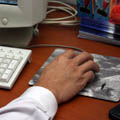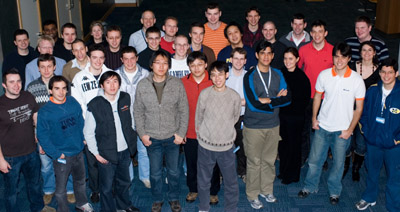A world of good
- 30 January 2007
 Joe Fernandez
Joe Fernandez
For 24 software development students from six countries, the past fortnight has been a real eye-opener on the realities of the challenges budding young entrepreneurs can face.
In a Dragon’s Den style, the students were asked to give a detailed ten minute presentation on the potential benefits their product could bring to the healthcare industry, and offer a detailed business case for the product, in front of a panel of six leading industry experts.
This was the conclusion to the Imagine Cup Innovation Accelerator programme, where the sponsors Microsoft and BT invited the teams to the Microsoft Innovation Centre in Reading to “harness their exceptional talents and take their ideas a step further toward commercial reality.”
The teams were in fact the top six Imagine Cup finalists from the main competition in India last October. They had already beaten 66 other teams to get this far and so expectations were high for they would demonstrate. The fact that there were no overall winners or losers made no difference to the pressure they were under.
The teams spent two weeks in Reading receiving comprehensive training in what it takes to develop an idea from a concept into a business. They were given access to all of Microsoft and BT’s current technologies and were able to expand their software proposals.
They were also given coaching on how to run their business and how to develop business plans to promote the product for the industry. The aim of the Innovation Accelerator programme, say Microsoft, is to turn their dreams into a reality.

Above: Six teams of four students, plus representatives from BT and Microsoft, at the Imagine Cup at the Microsoft Innovation Centre in Reading, Berkshire.
 Brazil: Virtual Eye
Brazil: Virtual Eye
Virtual Eye (vEye) is a system designed to give the blind information about their environment. Initially, Brazil were going to base the system on active radio frequency identification (RFID) tags located in cities and shopping centres, but since joining the Innovation Accelerator they found using software such as Microsoft’s MapPoint and community interaction could also help create a defined way for visually impaired people to get to a certain location.
Carlos Rodrigues, from Team Brazil, told EHI: “The ability for visually impaired people to get in and out of locations is a severe problem, which can also restrict their access to healthcare. We developed vEye by working with a blind friend and looking at ways to get him to and from locations easily. We developed a wristband which is GPS-enabled through a Bluetooth enabled smartphone and allows a user to be tracked
“The user will wear two wristbands on each arm and the direction they need to travel will be indicated by the particular wristband vibrating and voice commands to warn of any obstacles through the smartphone. At Microsoft, we have learnt how to make the product more community-based, so ordinary people can add obstacles to MapPoint maps for us. We have been able to work with the RNIB on the product.”
The panel said the idea was innovative and exciting, but the potential market needs exploring. Also, competitors were likely to take concepts of the product and make something new from it.
 China: Project Helen
China: Project Helen
China described ‘Project Helen’ as a new and innovative way of storing your personal health information and getting diagnosis without needing to go to a doctor’s surgery.
The team were looking to build a website where the patient will control their record and record any illnesses they may be feeling. With the patient’s consent GPs can then access these records and provide a form of diagnosis and treatment for the patient. The facility would also be able to be controlled using a mobile phone.
The unique thing about Project Helen, however, was a proposal for a PC-based gaming feature, which interprets your health data and encourages the user to do exercise – such as dancing or fighting – in a computer game. The concept is similar to the Nintendo Wii, but also refers health information back to your PC.
Zhang Zheng told EHI: “These components will allow for the user to have their profiles analysed and receive useful health suggestions from professionals. The gaming feature in particular is a convenient and exciting way of exercising which can help tackle childhood obesity problems and so on. The wristband controllers will detect movements and save activity levels onto the hard drive so both the users and professionals can see a healthy lifestyle is being achieved.”
The team worked extremely hard on the project for eight months, including working with the XBOX 360 team. The panel recommended that the team patent protect their product, and commended the team for the best use of technology out of the final six.
 Croatia: Smart.net EKG
Croatia: Smart.net EKG
Smart.net EKG runs on a mobile system such as a PDA, and uses sensors to monitor a patient’s heart rate, transmitting data to a dedicated server. If a problem is detected, an alarm message is sent to the patient’s doctor, attaching the patient’s GPS coordinates using Microsoft’s MapPoint.
Marko Velic told EHI: “Cardiovascular and heart diseases are the number one killers in modern society. Our goal is to enable early medical intervention in case of heart conditions. At Microsoft, we have been able to develop the technology using Microsoft MapPoint and SMS technology from BT. We have also been able to develop a good business case for the system and hope to be able to extend it from its pilot stages at our local Croatian hospital to mainstream use very soon.”
The panel were impressed with this technology, but warned of the large competition they would face in the telehealth sector.
 Italy: Hello World
Italy: Hello World
Italy won the Innovation Cup 06 with their Hello World project and presented it again at the Imagine Cup. Hello World aims to use technology to fill in the gaps of the doctor’s knowledge about what happened to their patient, and is principally designed for patients with phobias, disorders or stress related illnesses.
Giorgio Sardo of the Italian team explained: “Hello World was created to improve the relationship between medic and patient, supplying the doctor with important information often left out by the patient. For instance, by using MapPoint, doctors can see where a patient became ill for the first time using GPS technology, such as a person with claustrophobia who passed out at a crowded location or a person who became highly stressed and ill outside or inside of his working environment. It gives the doctors a better understanding of what is bothering their patient and can make treatment a lot easier.”
The panel said the team had progressed with the project well since winning the contest in India and should work on maximising its potential benefits by looking for doctors’ accreditation.
 Germany: Path finding system
Germany: Path finding system
Germany’s design is a new path finding system for people with disabilities. Much like Brazil’s system, it is designed specifically for people confined to a wheelchair. The system will be free and community controlled. Ordinary people can add locations to a database of maps and the system will display the most convenient route to the wheelchair user that avoids any potential hazards.
Mark Thomé told EHI: “We developed the system because we knew handicapped people who could benefit from maps like this. They have always had to plan routes in advance to make journeys as easy as possible, so we thought a mobile electronic map that guides people in their everyday lives with a wheelchair would help make a big difference to their journeys. Using MapPoint software, we have begun building such a map base and we believe the community will play a big part in expanding this service adding buildings and obstacles for this large part of the community.”
The panel agreed that this was an excellent idea that would offer disabled people a higher quality of service, and the group should look at marketing not just at electronic maps, but also at street guides and further franchise opportunities. They should also ensure they patent protect their idea.
 Norway: MediWatch
Norway: MediWatch
The final group to present was team Norway, who developed the MediWatch system, designed to monitor patients and distribute critical information to health professionals and families. The team finished third in the world finals in Delhi for its watch product. Since then, they have added extra features.
Gøran Hansen told EHI: “Working with Microsoft, we were able to use their new platform to experiment with a number of plug-ins that would help to sense and monitor a patient and send information to their relatives and GP, through their smartphone or similar device.
“This enables patients to take better care of themselves, and reassure their family and carers that they are well. In times of distress, a doctor can be contacted and can help resolve the situation quickly and family are less worried about their loved one’s condition.”
The panel told the Norwegian team their idea was a well-thought out and considered plan, but reminded the team of the need to consider privacy and consent in creating such a product. Nevertheless, they thought that Norway had the most compelling business case.
Microsoft’s Technology Centre manager, Lars Lindstedt, said: “More and more people will want independence and healthcare in their own homes, and the technology demonstrated here today shows that this is possible. There is definitely some good innovations here today, which I am sure the industry would want to adopt. Our 360 team worked with the Chinese team and the Norway team’s device showed great potential for the disabled. All showed several benefits and these students really are showing us what is possible for the future.
“The key to their success is to make sure that their technologies show some form of return and I think they all did that very well today. The coaching they have received will put them in great stead for their futures especially when you think that the leap in capabilities is so vast that even five years ago none of what we saw today would be possible, with real IT solutions for a ever growing IT world.”
While the students are able to maintain intellectual property rights, Microsoft and BT hinted they may help develop and bring some of their projects to the market.
BT Health’s chief technology officer, Diao Rinaldi added: “I was asked to look for possible investments and I can honestly say that there have been a few innovations today that have caught my eye and I will be discussing these with the board. Innovation is the future and we have to take what we have and build on it, that’s what we need. The showcase today showed us just how flexible health IT is and as we move to an era where more people use technology to aid them with their health control, I think these students should be encouraged to keep on innovating.”
As one panellist put it during the press conference: “The future is in front of us.”




